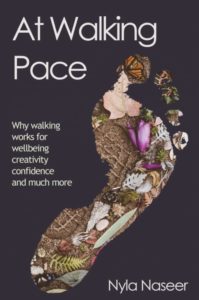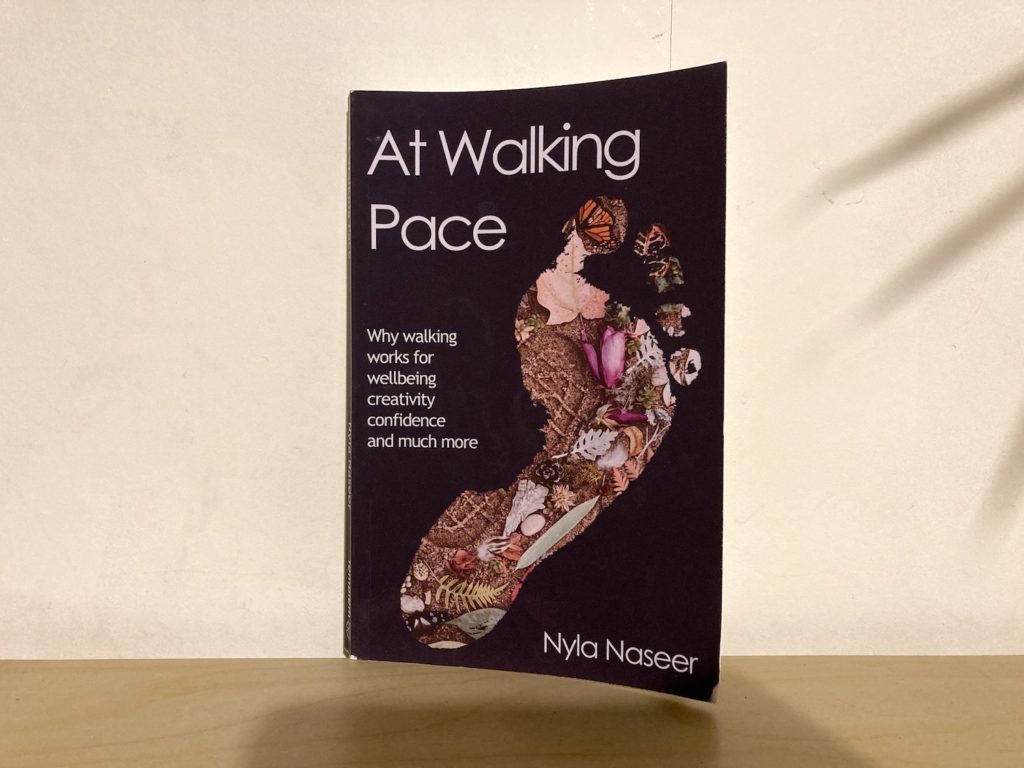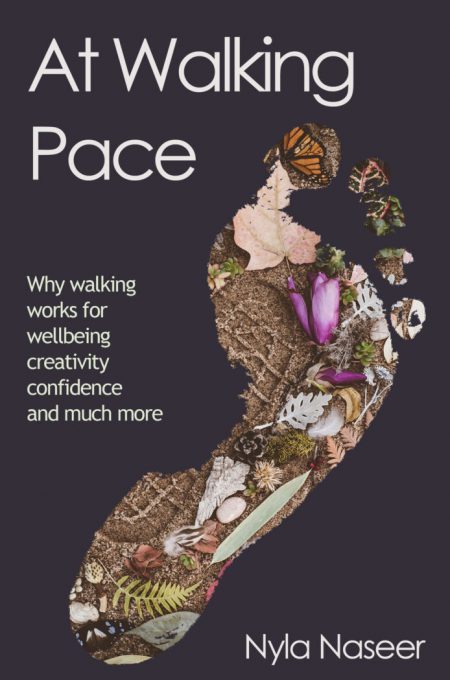Nyla Naseer is an author and walker based in King's Heath, Birmingham. During lockdown she wrote a book to celebrate walking. 'At Walking Pace' was published last month, is easy to read, well researched and has one of the most pleasing book covers of all the walking books!
Nyla's book is all about how walking can be used in different ways – for wellbeing, enjoyment, thinking and resilience.
Obviously we got in touch straight away to suggest going for a walk and to chat about walking in the process (because we are nothing if not meta here at Walkspace).
We also cheekily asked if we could republish an extract from the book. So thank you Nyla for the opportunity to support a local author. Here is the chapter on art and creativity that first lured us into buying the book.
Please do scroll to the end for links to buy At Walking Pace, to be a part of the accompanying podcast and to find out more about Nyla's work.
…

There is no universal definition of creativity, but a common definition outlines a creative idea as being novel or original as well as useful, adaptive, or functional. It is the first criteria that applies to the ‘arts’ and the second criteria that applies more to problem-solving and work (more of which later). Taken together, the two dimensions of creativity play an enormous part in shaping personal and societal development.
Earlier in this book I described how writers and philosophers though the ages have used walking to generate their ideas. For example, Aristotle, used to give lectures while walking around his school in Athens, followed by his pupils who became known as ‘peripatetics’ (meaning moving around). Charles Dickens was an avid daily walker who regularly walked twenty to thirty miles a day! Other groups of creatives, including musicians and visual artists have turned to walking to inspire them. Beethoven, for example, relied on daily walking forays for inspiration; during his walks he would continue to write music, scribbled on sheets of music paper that he carried with him.
Visual artists have long been inspired by the landscapes they walked within. Think of any painting by a landscape artist such as Turner and you will instantly feel aware of the walk that they took, ending up at the point that they decided to capture for us. Not only have artists used walking as a way of replenishing their energy and wellbeing, they have actively incorporated the walk as a way to record the world around them, stamping the identity of other walkers within their work. This, to me, is homage to walking itself.
Walking as an integral element of art has a long history. As walkers, artists gain the experience of more fully immersing themselves in their subject matter, or of considering elements such as the political, social or environmental relevance of their work. Walking is now present in art in many different ways: from collective art groups who go on walks, to the long history of political or protest walks that incorporate art forms such as music and banners. Walking and art are intertwined. Indeed walking is a legitimate form of expression in itself. Walking is an ‘attitude’.
Members of the Dada art movement in 1920s Paris organised a series of excursions to ‘places that have no reason to exist.’ Although only one of their nihilistic walks eventually took place, it sounds quite an event: the walk was accompanied by poetry recitals and was performed as a parody of a tour guide, making the walk a piece of performance art itself. A few decades later, artist and philosopher Guy Debord created walking maps highlighting ‘psychogeographic contours’ through the city, drawing attention to the ‘ambience’ elicited by different surroundings. His notion of ‘derive’ saw the city as a living organism, where a walk became a creative experience that generated feelings that could be put to use in any number of ways: from the political to the artistic (Hermon Bashiron Mendolicchio 2020). Thus, walking has long been part of a daringly avant-garde and counter-culture scene.
Some contemporary artists centre their work on walking. They make art where walking is the subject matter: Richard Long’s ‘A Line made by Walking’ photograph, showing a straight line of trampled grass receding towards tall bushes or trees at the far side of what appears to be a field, is a good example. Another is ‘walking artist” Hamish Fulton. Since 1973 Fulton has only made works based on the practice of walking, dispensing with what he feels are the materialistic shackles we live with and concentrating on the freedom that walking gives us to think and create. The walk as a symbol of simplicity and an escape from conformity is a well used artistic trope.
Another popular example of ‘walking as art’ is ‘The Lovers’, Artists’ Marina Abramović and Ulay’s 1988 performance, in which they stood 5,995 kilometres apart on the ruins of the Great Wall of China and began walking towards each other. They started from opposite ends: Abramović began from the mountainous provinces of The Yellow Sea while Ulay walked from the Gobi desert. The walk was intended as a metaphor for their love and longing, however it turned into something very different (especially since Ulay had an affair with his translator during the journey) but nevertheless interesting, dramatic and thought-provoking.
This association of walking and journeys with discovery and drama is very well exemplified in books and films, indeed there are too many to mention but I’ll pick out a couple. The classic ‘Wizard of Oz’ tells the allegorical story of Dorothy going through Oz ‘following the yellow brick road’ on a walk with her companions, whilst Cormack McCarthy’s ‘The Road’ offers a disturbing tale of a walk by a father and son though a dystopian post-nuclear destruction America. These two very different stories tap into our deep-seated identification with journeying on foot. The idea of a walk as a means of discovery is deeply embedded within written and visual culture.
Walking then is not a stranger to creative people. Historically, it has been appreciated as a thought and idea-provoking mechanism; walking therefore seems inextricably linked with the creative process. Does research reveal any rationale for walking promoting ideas creation? If indeed walking is a creative force then this opens the door for walking to become a tool, not just for artists but for work that needs people to think of ideas. So, does walking really have a positive effect on creative thinking and, if it does, what could be its greater impact at work?
[To find the answers, you'll have to read the book! – Ed.]
Extract from At Walking Pace © Nyla Naseer, 2020.
At Walking Pace is available through the various book retailers, including Amazon and Waterstones. There is also an At Walking Pace podcast – details below.
About Nyla

Nyla Naseer lives in Kings Heath. She is a writer, podcaster and vlogger. Her tough and totally un-stereotypical background brings alternative perspectives to her work.
She has a lifelong interest in people and ways of life, building a repertoire of knowledge for her writing and work on resilience, wellbeing and behaviour in general.
The outdoors, and walking in particular, has been central to her life and is a thread through her research and writing.
Nyla has two masters degrees and a BSc but describes herself as a ‘street-hustler type’ and ‘an interesting person with potential’.
Podcast opportunity
Nyla is interested in interviewing fellow walkers for the At Walking Pace podcast, which broadcasts on Spotify, Apple, Google and more.
In it, she talks to guests about walking, taking them on random walks and sharing views and ideas about living in a more human-paced way. The podcast encourages walking, lo-fi living, and taking things a bit less seriously.
If you're interested, please get in touch via her website: At Walking Pace. You can also listen to the latest podcast and read more about Nyla's work there, too.

